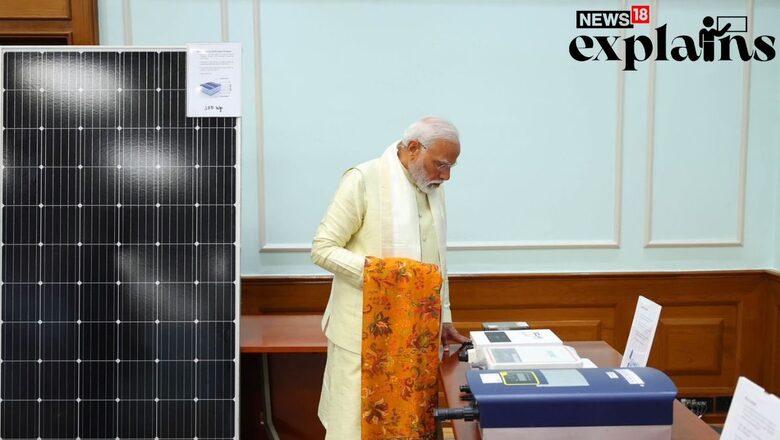
views
Prime Minister Narendra Modi on Monday announced the ‘Pradhan Mantri Suryodaya Yojana’, a government scheme under which one crore households will get rooftop solar power systems.
“I have taken my first decision after returning from Ayodhya that our government will launch ‘Pradhan Mantri Suryoday Yojna’ with the aim to install rooftop solar systems in one crore houses,” PM Modi said on X.
What is the Pradhan Mantri Suryodaya Yojana?
Pradhanmantri Suryodaya Yojana has been launched with the target of installing rooftop solar on 1 crore houses.
The scheme will not only reduce the electricity bill of the poor and middle class, but will also make India self-reliant in the energy sector.
सूर्यवंशी भगवान श्री राम के आलोक से विश्व के सभी भक्तगण सदैव ऊर्जा प्राप्त करते हैं।आज अयोध्या में प्राण-प्रतिष्ठा के शुभ अवसर पर मेरा ये संकल्प और प्रशस्त हुआ कि भारतवासियों के घर की छत पर उनका अपना सोलर रूफ टॉप सिस्टम हो।
अयोध्या से लौटने के बाद मैंने पहला निर्णय लिया है कि… pic.twitter.com/GAzFYP1bjV
— Narendra Modi (@narendramodi) January 22, 2024
However, no information on a timeline has been given for such installations. The Prime Minister shared photographs of his meeting with officials from the Ministry of New and Renewable Energy including the Union Minister RK Singh and Secretary Bhupinder Bhalla.
As of July, 2023, only 2.2 GW worth of rooftop installations have been installed in Indian homes, a report in The Hindu said citing information presented to the Lok Sabha.
Why Did PM Modi Announce This Scheme?
India is the world’s third-largest producer of electricity having a total installed capacity of 356 GW. Of this, around 64 percent comes from thermal energy (54.60 percent from coal, 7 percent from gas and 0.2 percent from diesel), 2 percent from nuclear power, 13 percent from large hydro, and 21.8 percent from renewables (wind, solar, biomass, waste-to-energy).
The government is planning to change the trend, with plans to achieve a total of 500 GW of renewable energy capacity by 2030, with at least 280 GW of it coming from solar. Prime Minister Narendra Modi announced that the country has set its target of producing 50% of its energy needs through non-fossil fuels by the end of this decade.
The government also intends to grow EV sales in India to capture the markets of 30 per cent of private cars, 70 per cent of commercial vehicles and 80 per cent of two- and three-wheelers by 2030. PM Modi also announced at COP26 that India would become carbon neutral by 2070.
Previous Solar Schemes
In 2014, the government launched the Rooftop Solar Programme to expand the rooftop solar installed capacity in the residential sector by providing Central Financial Assistance and incentives to distribution companies.
The programme aims to increase rooftop solar installed capacity to 40 GW by 2026 and is currently in its second phase, according to The Indian Express.
India’s Push for Green Energy
India, with a population of over 1.4 billion, is on the frontline of climate change mitigation. According to the International Energy Agency (IEA), India will have to expand its power system in the next two decades in order to meet the growing energy demands and has to tackle toxic air quality in big cities at the same time.
India’s green energy ambitions are an aspirational target to show the world that we are moving in the right direction. As of June 2023, India has increased its installed renewable energy capacity to 176.49 GW compared to 115.94 GW in March, 2018.

















Comments
0 comment